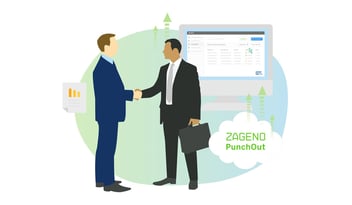R&D procurement has come a long way. Procurement’s evolution has been marked by monumental shifts; from analog to digital, manual to automated, local to global, siloed to consolidated, and transactional to strategic. Beginning in the 2010s, advanced analytics and big data became the new buzz words, with the rise of AI and automation technologies not far behind. According to a McKinsey Global survey, one-third of respondents stated that their organizations are already using generative AI (GenAI) in at least one business function, with 40% saying that their organizations will increase their investment in AI in the near future. The AI industry is estimated to reach a value of $500 billion by 2024. Though the use of AI for procurement is still in its early stages, its impact on the procurement function of the future cannot be underestimated. So, here’s the question on everyone’s mind: Will AI be friend or foe to the R&D procurement organization of the future?
According to John Dickson, a forty-year sourcing industry veteran and former Astra Zeneca Chief Procurement Officer, the answer of whether AI is a threat or an opportunity to R&D procurement all depends on how you look at it.
In Procurement Unleashed: From Cost Cutter to Strategic Innovator, Diaries of a CPO, a recent webinar with Dickson and Florian Wegener, co-founder and CEO of lab supply marketplace ZAGENO, the ramifications of AI to procurement and many other pressing topics were explored.
Dickson shared, “If you look at AI as a threat, then you won’t embrace it the right way. Over forty years, procurement has evolved significantly and will continue to evolve over the next ten years. I don’t think procurement will disappear in ten years, but will evolve into something different.” It is important to examine how AI will augment and accelerate sourcing, as well as the challenges it poses to the function itself.
Potential applications of AI for R&D procurement
There are many ways to harness the power of GenAI to improve R&D procurement strategy and overall efficiency. Per a 2023 Accenture report, “Once integrated into the rapidly evolving digital procurement landscape, GenAI applications can transform a wide range of procurement capabilities. They’ll do this by augmenting teams on routine tasks and, by acting as a co-pilot to category leaders, providing strategic value-add through inspiration on-demand.” The list of how AI can revolutionize the procurement function is ever-growing, and includes:
- Quicker, deeper data collection and analysis. Not only can AI rapidly crunch large data sets to process scenario-based results, it can generate actionable insights based on demand profiles, supplier performance, and historic trends. AI can quickly aggregate, analyze, and contextualize data from internal and external sources. This strength can also be applied to monitor potential regulatory compliance issues, geopolitical challenges, and supply chain disruptions.
- Increased efficiency through leverage of complex automation. Redundant tasks such as manual data entry, error validation, document creation, and supplier onboarding can be performed by AI, reducing labor inefficiencies associated with routine purchasing functions.
- Identification of cost optimization and savings opportunities. By leveraging predictive modeling, data analytics, and decision-making algorithms, AI can easily forecast demand, identify possible cost leakage areas, compare cost and term benchmarks across suppliers, and much more. AI also makes possible a more perfect competitive marketplace, with the potential to manage and make available hundreds of thousands of vendors to buyers.
- Enhanced stakeholder experience. With access to current category-specific market intelligence and innovation trends, AI provides opportunities to offer enhanced value for stakeholders. Additionally, GenAI utilizes Large Language Models (LLM) to provide hyper-personalized interaction with buying users and guide them towards preferred suppliers.
The challenges of AI to R&D procurement
With any new technology, there are always risks posed to the workforce employing it. Automation has long been perceived as a possible threat to those whose livelihoods depend on the tasks being offloaded, and it is very possible for procurement to view AI with the same hesitation. Potential concerns include:
- Job displacement. As AI technologies automate routine and repetitive tasks, there is a risk of certain functions within R&D procurement becoming obsolete, mainly the more operational tasks centered in the purchasing arena.
- Upskilling challenges. Strategic use and management of AI technology may require a skillset that current procurement professionals do not have and will need to address through training and skill development.
- Suboptimal decision-making. Overreliance on AI-generated recommendations may result in less-than-optimal outcomes due to ignoring the critical human elements of creativity, nuance, and intuition. Moreover, AI systems are trained using historical, sometimes biased, data, which can lead to algorithmic bias. This bias can lead to unfair decision-making, showing favoritism toward specific suppliers while potentially excluding others.
- One-size-fits-all tech stack mentality. There are thousands of third-party procurement, productivity, and other applications available to R&D organizations. Enterprise resource platforms (ERP) are beginning to offer central AI hubs through which companies can manage best-of-breed bolt-ons. Stakeholders interested in optimizing efficiency may rush to employ this strategy without considering how to seamlessly implement these elements within the technology landscape.
- Stakeholder trust erosion. Lack of visibility into the workings of certain AI algorithms can pose challenges in understanding and explaining the purchasing decision-making process. This lack of transparency may lead to stakeholder distrust in the outcome of the procurement function.
Despite these challenges, it’s an exciting time for R&D procurement. According to Dickson, the procurement function won’t go away, but must adapt and change. “If we put our heads in the sand, we will struggle,” he said.
To continue to evolve, procurement must harness the upsides of AI to help stakeholders navigate and thrive in these uncharted waters. By embracing AI technologies and incorporating them strategically into procurement processes, R&D procurement can further solidify and elevate its role within biotech and pharma organizations. By leaning into R&D procurement’s role as trusted advisor and strategic guide in the face of the AI revolution, the procurement function will continue to evolve and keep an important seat at the table in the life sciences industry.
For more expert insights on the future of procurement in the life science industry, watch Procurement Unleashed: From Cost Cutter to Strategic Innovator, Diaries of a CPO with John Dickson and Florian Wegener.
About ZAGENO: With over 40 million product SKUs available from more than 5,000 leading brands, ZAGENO offers the largest life sciences lab supply marketplace. Our one-stop shop solution helps scientists, lab managers, and procurement leaders compare products across vendors, easily source product alternatives, track deliveries, and communicate order status with R&D teams in real time. We utilize machine learning and AI to help buyers experience the most convenient, comprehensive, and efficient purchasing experience for life science and research supplies.




